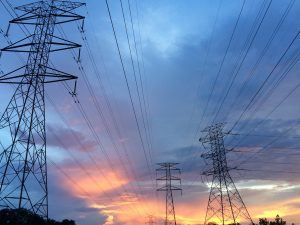A Bright Future for Electric Transmission & Distribution
June 16, 2020
“In 2019, the multiyear pattern of record-breaking utility capital expenditures amid stagnant load growth continued in the power industry. And it shows few signs of changing as the need to upgrade aging infrastructure, digitize, and secure the grid against natural and manmade disasters continues.” – Source: Deloitte 2020 Power and Utilities Industry Outlook.
Energy Transmission

 Have you ever wondered how energy reaches your home or business to power your lights, TV, and charge your electronics at the flip of a switch? Energy is delivered to consumers through a complex network. First, it is often generated at a power plant and moves through a grid of above ground and underground electrical lines. The grid houses electricity substations, transformers, transmission, and distribution lines that connect producers of energy with consumers. Many times, energy must travel long distances to reach a consumer through high voltage transmission lines. Energy “Transmission” refers to the bulk movement of electrical energy from a generating site. Electrical energy then arrives at substations where transformers reduce the voltage so the electrical energy can then be distributed to the end-user.
Have you ever wondered how energy reaches your home or business to power your lights, TV, and charge your electronics at the flip of a switch? Energy is delivered to consumers through a complex network. First, it is often generated at a power plant and moves through a grid of above ground and underground electrical lines. The grid houses electricity substations, transformers, transmission, and distribution lines that connect producers of energy with consumers. Many times, energy must travel long distances to reach a consumer through high voltage transmission lines. Energy “Transmission” refers to the bulk movement of electrical energy from a generating site. Electrical energy then arrives at substations where transformers reduce the voltage so the electrical energy can then be distributed to the end-user.
Changing the Energy Landscape
A growing need for utilities to upgrade and modernize their electric transmission and distribution grid is emerging. Because of this, many commercial power providers plan to invest heavily in their electric power transmission and distribution networks.
There are several reasons to update energy infrastructure:
- Much of the current grid has reached the end of its useful life and is failing to keep up with population and construction trends in developing areas. Grid reliability and resilience is critical.
- New or updated lines and substations provide a way for clean or renewable energy technologies to get their product to market (from large Solar and Wind sites which are often located in rural areas under-served by the current electrical grid in those areas). Learn more.
- Moving lines underground helps reduce outages in storm-prone areas.
- Enhancing grid technologies allows remote self-identification of problems and re-routing of power thereby decreasing outage numbers and duration.
- Advancing smart metering infrastructure enables utility companies to implement more bill-lowering tools.
- Protecting against physical and cyber-security threats helps keep the grid safe (grid hardening).
- Advanced and newer technology is more efficient to operate and cheaper in the long-term for customers.
Opportunity for Consulting Firms
As utility companies update their electric transmission and distribution, they will spend billions of dollars in total. This results in opportunities for engineering and consulting firms during various stages of these multiyear, complicated projects. Not only must the system be designed, components manufactured, routes planned, assessments made, permits obtained and regulators satisfied, but the physical construction must be performed in a quality manner subject to various constraints. Commercial power suppliers are sensitive to the potential impact their projects could have on the environment and in the communities they serve, and will look to consulting firms to help reduce these potential impacts. This appropriate concern on behalf of the power suppliers and the regulatory environment applicable to this type of development provides substantive and challenging work opportunities for the engineering and consulting industry to benefit and improve communities.
For more information on S&ME’s Power Market, please visit: https://www.smeinc.com/markets/power
Contact Us
If you have questions regarding energy services, please contact Marty Baltzegar.
